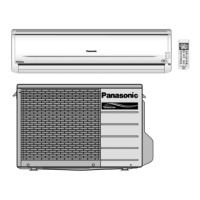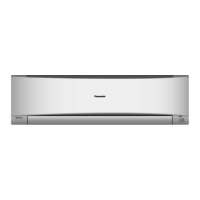71
12.4 Airflow Direction
There are two types of airflow, vertical airflow (directed by horizontal vane) and horizontal airflow (directed by
vertical vanes).
Control of airflow direction can be automatic (angles of direction is determined by operation mode, heat
exchanger temperature and intake air temperature) and manual (angles of direction can be adjusted using
remote control).
12.4.1 Vertical Airflow
CS-S9/12TKV
Operation
Up-and-down inner vane
Step 1 Step 2 Step 3 Step 4 Step 5
Cooling
Auto [110] degrees – [65] degrees
Manual [110°] 110° 90° 70° [65°]
Dry
Auto [110] degrees – [65] degrees
Manual [110°] 110° 90° 70° [65°]
Operation
Up-and-down outer vane
Step 1 Step 2 Step 3 Step 4 Step 5
Cooling
Auto [50] degrees – [85] degrees
Manual [50°] 62° 72° 83° [85°]
Dry
Auto [50] degrees – [85] degrees
Manual [50°] 62° 72° 83° [85°]
CS-S18/24/28TKV
Operation
Up-and-down inner vane
Step 1 Step 2 Step 3 Step 4 Step 5
Cooling
Auto [140] degrees – [90] degrees
Manual [140°] 135° 120° 105° [90°]
Dry
Auto [140] degrees – [90] degrees
Manual [140°] 135° 120° 105° [90°]
Operation
Up-and-down outer vane
Step 1 Step 2 Step 3 Step 4 Step 5
Cooling
Auto [47] degrees – [74] degrees
Manual [47°] 58° 64° 69° [74°]
Dry
Auto [47] degrees – [74] degrees
Manual [47°] 58° 64° 69° [74°]
Automatic vertical airflow direction can be set using remote control; the vane swings up and down within the
angles as stated above. It does not swing during fan motor stop. When the air conditioner is stopped using
remote control, the vane will shift to close position.
Manual vertical airflow direction can be set using remote control; the angles of the vane are as stated above and
the positions of the vane are as figure below. When the air conditioner is stopped using remote control, the vane
will shift to close position.

